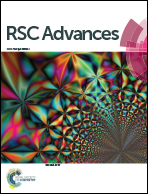One-pot synthesis of nitrogen-enriched carbon spheres for hexavalent chromium removal from aqueous solution
Abstract
Nitrogen-enriched carbon spheres (NECS) were obtained after ZnCl2 activation of high-nitrogen-content polymer spheres prepared by one-pot hydrothermal synthesis using m-phenylenediamine and hexamethylenetetramine as raw materials. The NECS were characterized by SEM, BET, FT-IR, and XPS. It was found that the NECS possessed homogeneously spherical morphology with diameters of about 0.6–1.2 μm and a high specific surface area (1237 m2 g−1). Elemental analysis indicated that the nitrogen content of NECS was up to 10.21 wt%. When the hexavalent chromium (Cr(VI)) in acidic solution was used to evaluate the adsorption performance, the maximum Cr(VI) removal capacity was as high as 279 mg g−1 at pH 2.0. The pseudo-second-order and Freundlich model fitted the Cr(VI) adsorption behavior well. Based on zeta potential and XPS analysis, the Cr(VI) removal mechanism was proposed to be electrostatic adsorption of Cr(VI) anions on the NECS surface at low pH, followed by a reduction reaction of Cr(VI) to Cr(III) via the nitrogen functionality of carbon spheres and possible coordination reaction of the resulting Cr(III) with the lone pair electrons of nitrogen. The NECS adsorbent was shown to maintain over 90% Cr(VI) removal efficiency after six cycles. Finally, the Cr(VI) removal efficiency of NECS reached 99.9% with a dosage of 12 g L−1 for real acidic electroplating wastewater (initial concentration 936.68 mg g−1 and pH 1.5), clearly showing the promise of this novel adsorbent for treating Cr-containing wastewater.


 Please wait while we load your content...
Please wait while we load your content...